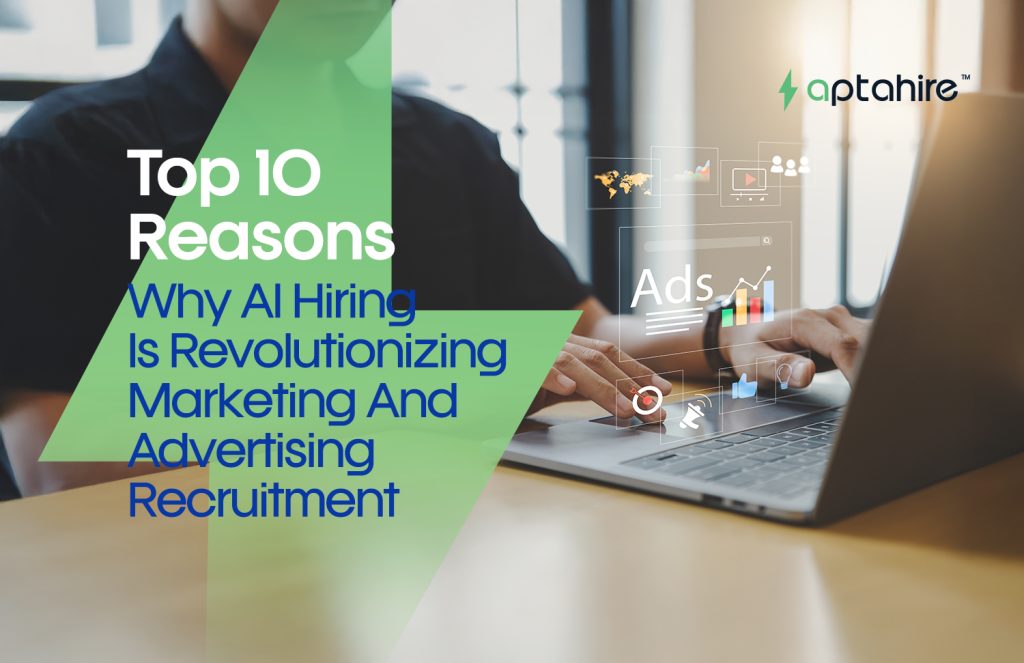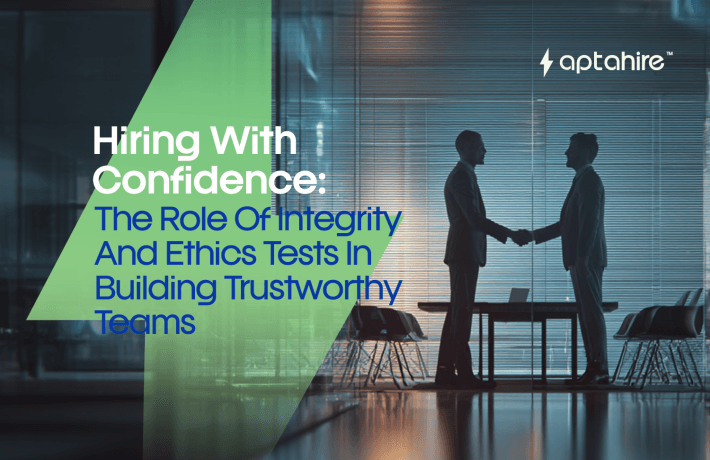Top 10 Reasons Why AI Hiring is Revolutionizing Marketing and Advertising Recruitment

Introduction
The marketing and advertising industry thrives on innovation, agility, and data-driven decision-making. Hiring in this domain, however, presents unique challenges. Recruiters are expected to identify talent that not only understands traditional and digital marketing but is also capable of adapting quickly to evolving consumer trends, mastering new platforms, and delivering ROI-driven campaigns. In such a fast-paced environment, artificial intelligence is becoming more than just a helpful tool, it is a transformative force.
AI hiring systems are reshaping how talent is sourced, evaluated, and onboarded. By integrating machine learning, natural language processing, and predictive analytics into recruitment workflows, agencies and marketing departments are significantly enhancing both efficiency and accuracy in their hiring process. This blog dives deep into the top 10 reasons why AI is revolutionizing marketing and advertising recruitment, supported by industry data, insights, and expert analysis.
1. Precision Targeting of Creative and Analytical Talent
AI platforms can scan vast candidate databases, social profiles, and content portfolios to match specific marketing skills like SEO, paid media, performance marketing, or creative storytelling with job requirements. These tools use semantic analysis to understand nuanced language and can identify hybrid talent, like data-savvy creatives or analytically-minded content strategists, who might be overlooked by traditional systems.
2. Automation of Repetitive Recruitment Tasks
Sourcing candidates, screening resumes, scheduling interviews, and responding to common queries can consume hundreds of hours. AI-based recruitment tools automate these functions through intelligent chatbots, resume parsers, and smart interview schedulers. This frees up recruiters to focus on strategic hiring, candidate experience, and employer branding.
3. Enhanced Candidate Experience Through Personalization
AI hiring tools personalize the application journey based on candidate behavior and preferences. From curated job suggestions to dynamic email nurturing sequences, candidates receive relevant, timely communication that reflects the brand’s professionalism and engagement. A positive experience strengthens the employer brand, a crucial factor in attracting top-tier marketers.
4. Real-time Analytics for Hiring Performance
One of AI’s most significant benefits is its ability to provide actionable insights in real-time. HR and recruitment teams can access dashboards that show time-to-hire, source effectiveness, conversion rates at each funnel stage, and diversity metrics. These analytics help optimize recruitment marketing campaigns, budget allocation, and sourcing strategies with data-backed decisions.
5. Competency Mapping Using Predictive Models
In marketing, skills are often dynamic. AI platforms can assess transferable skills using past job data, educational background, and online presence to predict how well a candidate will perform in a new marketing role. For example, a performance marketer transitioning to a growth strategist role might be flagged as high potential based on behavioral and cognitive pattern recognition from AI models.
6. Bias Reduction and Diversity Hiring
Bias, both conscious and unconscious, has long influenced hiring decisions in advertising and media. AI hiring tools anonymize applications by removing names, photos, and gender identifiers, allowing for objective evaluation. Moreover, AI can be trained to ensure inclusive job descriptions and assess whether hiring practices support diverse candidate outreach.
7. Portfolio and Campaign Analysis at Scale
Creative portfolios, campaign case studies, and marketing analytics reports are often critical in hiring top-tier talent. AI systems are now capable of evaluating visual and textual data at scale. Using NLP and image recognition, AI can assess campaign KPIs, messaging clarity, and design consistency to provide a more holistic view of a candidate’s past work.
8. Skill Gap Identification and Internal Mobility
AI doesn’t just identify external talent; it helps companies understand internal capabilities. By mapping employee skills, certifications, and growth trajectories, AI can suggest internal promotions, lateral moves, or reskilling opportunities. In a fluid industry like marketing, where roles constantly evolve, this internal agility can reduce attrition and boost retention.
9. Faster Hiring with Better Fitment
Time-to-hire is a crucial metric, especially when projects or campaigns are deadline-driven. AI reduces hiring cycles by automating the pre-screening and assessment process while improving fitment accuracy. Predictive analytics can score candidates based on likelihood of success in specific roles, reducing costly mis-hires and increasing productivity.
10. Strategic Workforce Planning for Future Marketing Needs
Marketing roles are shifting rapidly, with emerging needs in AI-generated content, influencer marketing analytics, customer journey mapping, and voice search optimization. AI hiring systems use labor market intelligence and trend forecasting to help organizations prepare for these shifts. With proactive workforce planning, companies can build a future-ready marketing team.
Industry Trends and Statistics
According to LinkedIn’s Global Talent Trends report, 67% of hiring managers believe AI saves time in the recruitment process. In the marketing and advertising space, more than 55% of companies are investing in AI to enhance their digital recruitment capabilities. Furthermore, companies using AI in hiring report a 30% improvement in time-to-hire and a 25% increase in candidate quality.
A recent survey by Gartner shows that 74% of CMOs are increasing investments in marketing operations and analytics roles. With this shift, demand for hybrid marketers who understand both data and storytelling is rising, and AI is playing a central role in sourcing such talent.
Tips and Best Practices
- Train recruitment teams to understand AI models and data interpretation.
- Choose AI tools that are transparent, auditable, and compliant with data privacy laws.
- Regularly audit AI algorithms for unintended bias or skewed outcomes.
- Use AI as a decision-support tool, not as a sole decision-maker.
- Balance automation with human judgment for final candidate selections.
Interesting Facts
- IBM’s Watson Recruitment reduced bias in hiring by up to 80% in pilot studies.
- Adobe uses AI to match marketing interns to teams based on personality and skill alignment.
- AI video interview tools can assess tone, speech cadence, and language fluency in under 90 seconds.
Final Thoughts
Marketing and advertising have always been at the forefront of creativity and technology. Now, the way agencies and brands hire their teams is undergoing a similar transformation. AI hiring isn’t about replacing recruiters; it’s about empowering them with precision, speed, and insight. By embracing this evolution, marketing teams can build smarter, more agile workforces ready to meet the challenges of tomorrow.
The recruitment journey is no longer linear. It’s dynamic, data-driven, and increasingly personalized. With AI in the mix, marketing and advertising companies are no longer just filling vacancies, they are building talent ecosystems. As the technology matures, those who invest early in AI hiring will gain a strategic edge, not just in finding talent but in shaping the future of marketing itself.
FAQs
1. How does AI improve the accuracy of marketing and advertising talent acquisition?
AI enhances accuracy by analyzing vast datasets from resumes, portfolios, and online profiles to match candidates with the right mix of creative, analytical, and platform-specific skills. It uses semantic understanding and pattern recognition to identify hybrid professionals who might be missed by traditional screening methods.
2. Can AI tools evaluate creative portfolios effectively in the marketing field?
Yes, advanced AI tools equipped with Natural Language Processing (NLP) and computer vision can evaluate creative portfolios at scale. These tools assess campaign case studies, visual consistency, messaging impact, and even brand alignment through contextual and performance-based data points.
3. In what ways does AI hiring reduce bias in the recruitment process?
AI reduces bias by anonymizing applications, removing identifiers such as name, gender, and photo, to ensure objective shortlisting. Additionally, AI can analyze job descriptions for inclusive language and monitor diversity metrics across hiring funnels, encouraging more equitable outcomes.
4. How does AI help with workforce planning for future marketing needs?
AI hiring systems analyze labor market data, skill trends, and historical hiring patterns to forecast future talent requirements. For instance, it can identify the rising demand for roles in influencer analytics or AI-generated content and help companies proactively build talent pipelines for these emerging functions.
5. Does AI hiring replace human recruiters in marketing and advertising roles?
No, AI hiring complements rather than replaces recruiters. It automates time-consuming tasks like resume screening, scheduling, and initial assessments, allowing human recruiters to focus on relationship-building, strategic planning, and final decision-making based on cultural and team fit.
6. How can AI personalize the candidate experience during recruitment?
AI personalizes the journey by offering role recommendations based on candidate behavior, tailoring communication timelines, and sending targeted follow-ups. This enhances engagement, reduces drop-offs, and strengthens employer branding, critical in attracting top-tier marketers.
7. What should marketing companies look for when choosing AI recruitment tools?
Companies should prioritize tools that offer transparency, auditability, and compliance with data privacy laws. Features like real-time analytics dashboards, unbiased candidate evaluation, and integration with internal mobility platforms can significantly increase hiring success in dynamic marketing environments.



